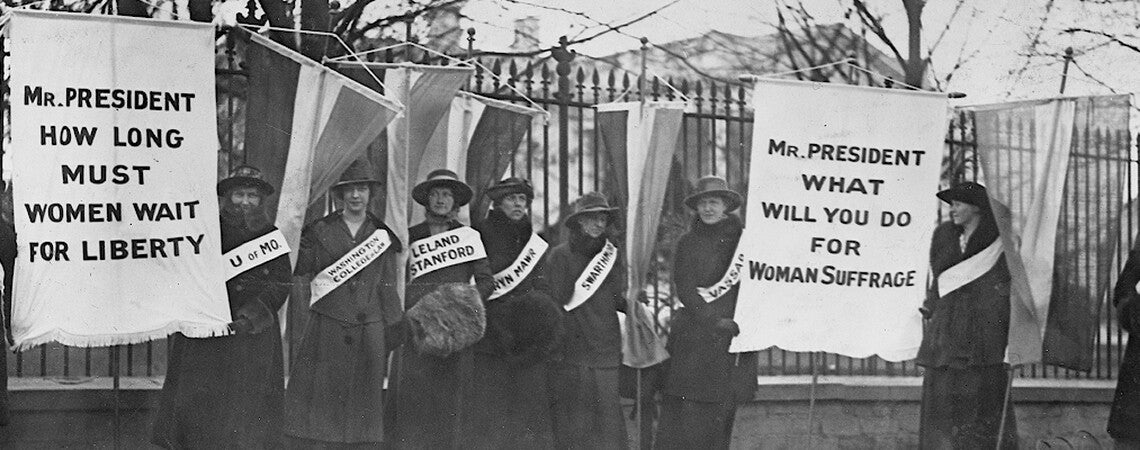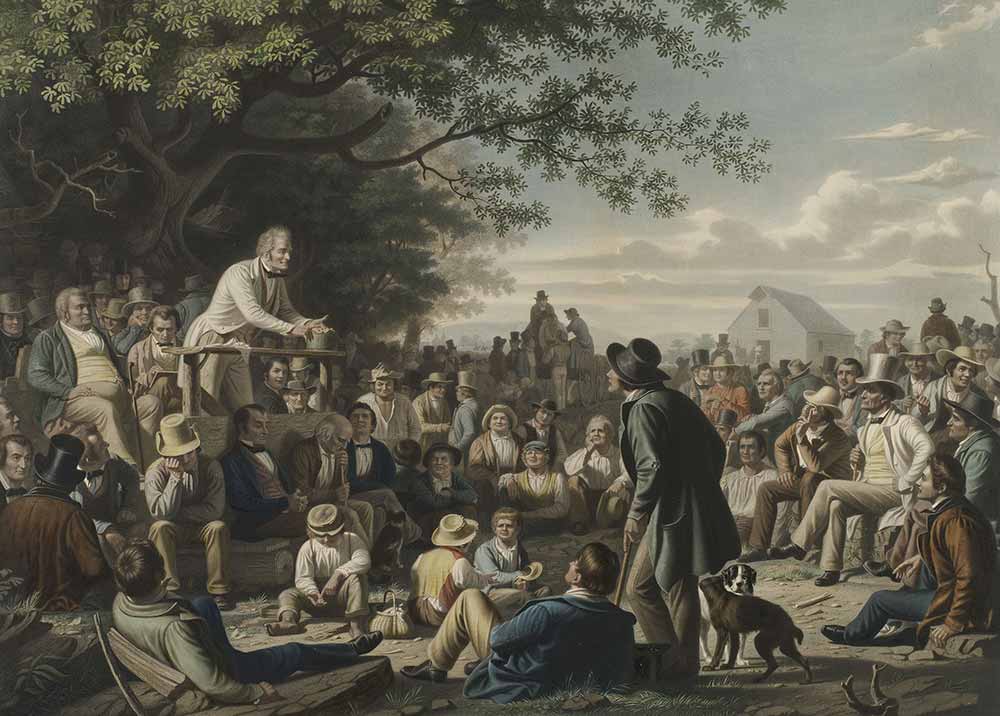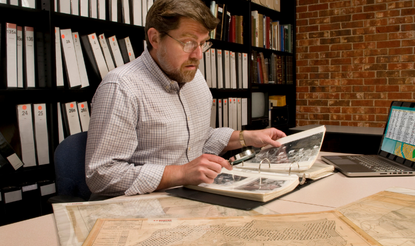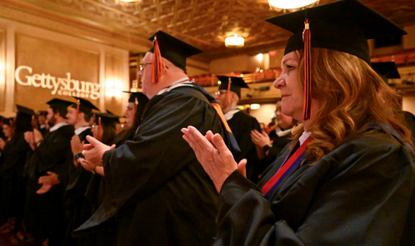Making (White Male) Democracy: Suffrage Expansion in the United States from the Revolution to the Civil War
by Stuart M. Blumin
There is perhaps no theme more central to our traditional understanding of American history than the expansion of democracy. And in that long story of democratization we habitually regard as our peculiar contribution to the world, nothing is more central than the extension of the right to vote—from the propertied to the poor, from men to women, from European-descended whites to people of all origins and shades of skin. This is a story we delight in telling, for it is easily understood as a key element in the advance from monarchy to self-rule, and in the realization and preservation of personal liberty—the things we take to be the principal validations of our history as a nation.
In telling this story, historians of suffrage expansion remind us of the complexities, the struggles, and the frequent setbacks that complicate what might otherwise seem a straightforward—and inevitable—triumph of democracy. Particularly in the period following the one described here—the late nineteenth- and early twentieth-century struggle for women’s suffrage, and the still longer battle for safe and certain ballot access for African Americans (still uncertain, more than a century and a half after the adoption of the Fifteenth Amendment to the Constitution)—gaining the right to vote was and continues to be a long and difficult process, teaching us that Martin Luther King’s “arc of history” can still bend backward as well as forward. The expansion of white male suffrage in the generations following the American Revolution was less fraught with resistance and disappointments, but here too are complications to the narrative of simple democratic triumph.
The baseline of this part of the story can be set in the years just before the American Revolution, when all but one of the North American British colonies maintained an age-old system restricting the vote (for all but some local elections) to property-owning men. The assumption that underlay this system was that voting could be entrusted only to those who had a tangible stake in their society, and in an agricultural and paternalistic world this meant, primarily, those men who owned freehold estates above a certain acreage or assessed value. Seven of the thirteen colonies adhered to the letter of this tradition, while five, recognizing the growing populations of their towns, counted other forms of property. South Carolina, while maintaining a fifty-acre freehold qualification, extended the franchise to less-propertied men who paid taxes of at least twenty shillings.
These systems were rarely contested, largely because enfranchisement was commensurate with a fairly widespread ownership of property in all the colonies. But significant minorities of men did not qualify for the vote, and the Revolution soon brought new impulses to bear on the legitimacy of long-standing restrictions. Apart from the ringing assertion in the Declaration of Independence that “all men are created equal,” the exigencies of the Revolution created new forms of public participation by less-propertied and even propertyless men. Revolutionary leaders understood that to win the struggle for independence ordinary people had to be mobilized, not merely as cannon fodder, but also as active, expressive citizens. Some served on local Committees of Safety and Correspondence; many more served on various ad hoc committees and raised their voices at popular rallies that were especially common in the port towns. Many unpropertied militiamen gained the right to elect their own officers, and in the process developed a feisty sense of democratic entitlement that easily carried over to civilian life.
During and after the Revolution, in response to these new forces, most of the thirteen newly empowered states made at least modest changes to their electoral systems, expanding in varying degrees the proportions of men who were entitled to vote. Georgia joined South Carolina in adding a taxpayer option to its property qualification, while Pennsylvania, New Hampshire, and North Carolina abandoned property qualifications for at least lower-house elections—a quite radical step in its time—in favor of a franchise based entirely on fairly low levels of taxation. According to historians’ estimates, qualifying taxpayers amounted to some 90 percent of adult white males in these states. At least four other states, meanwhile, lowered property thresholds, raising the eligible voting population by lesser numbers.
In the first decades of the growing republic it was, however, the newer states, less constrained by suffrage traditions, that made the most striking movements toward a more inclusive electorate. The first new state beyond the original thirteen, Vermont, brought universal manhood suffrage into the Union in 1791, and Kentucky followed a year later, although it soon amended its system to limit the franchise to whites. Of the first eleven new states, from Vermont to Missouri, eight had no economic-based suffrage qualifications, and two (Ohio and Mississippi) had a very low taxpaying requirement that excluded few white male voters. Only Louisiana maintained a taxpaying threshold high enough to disqualify half or more of the white male population. And Louisiana was a special case, in which a still-powerful Creole population answered the challenge of an incoming horde of Anglo-American white settlers, in part by limiting their votes.
It would appear, then, that in the nation as a whole the most significant progress toward a more inclusive white male suffrage occurred in the late eighteenth and early nineteenth centuries, well before the Jacksonian presidency that remains to many the pivotal era of democratic expansion in the United States. The Jacksonian era and its immediate aftermath experienced striking changes in political party organization and popular campaigning, both of which promoted the ethos, if not the reality, of democratic self-rule. But if these things related to suffrage expansion it was more as a consequence than a cause. Even by the beginning of the century, as we have seen, many states, original and new, had expanded the adult male franchise in notable ways. Historians’ estimates of these changes vary, but the most recent ones suggest that as many as 80 percent of adult white males were eligible to vote in the nation as a whole in 1800. And in those original states that had been most reluctant to expand the franchise before that date, the surrender or weakening of economic-based voter qualifications did occur, often well before and, curiously, well after, Andrew Jackson occupied the White House. Maryland surrendered its property qualification in 1802, while four states (New Jersey, Connecticut, Massachusetts, and New York, in that order) switched from a property to a more generous taxpaying qualification by 1821. Rhode Island and Virginia finally eliminated their property qualifications in 1842 and 1850, while New Jersey, Connecticut, Ohio, and a now Anglo-infused Louisiana adopted white manhood suffrage between 1844 and 1851. On the eve of the Civil War a handful of states retained a taxpayer qualification, but it is fair to conclude that a near-universal white manhood suffrage had been achieved in the United States.
 Three important points must be made about this seemingly relentless march toward a broader, more democratic electorate. One is that suffrage expansion in this era was compromised by specific limitations and even by contractions. In many places, even as economic qualifications receded, other limits to voting were preserved or stiffened. Paupers were often denied the vote, as were felons, and residency requirements were frequently increased, especially where foreign immigration threatened to reshape the electorate. More strikingly, as more white males gained the vote, others actually lost it. Women had possessed the right to vote in only one state, New Jersey, but they lost that right in 1807, when the state restricted the franchise to men. The same thing happened to black voters in a number of states. During the years of property qualifications in New York and other states, a small number of property-owning African Americans cast legal votes. But as economic qualifications were lowered or removed, larger numbers of black men stood to gain the vote along with previously disenfranchised whites. So state legislators and convention delegates remembered, not always at first, to confine the franchise explicitly to white men. This happened in New York, where an 1821 constitutional convention expanded voting eligibility without addressing race—an oversight corrected in 1826 by an amendment that eliminated voting by all African Americans.
Three important points must be made about this seemingly relentless march toward a broader, more democratic electorate. One is that suffrage expansion in this era was compromised by specific limitations and even by contractions. In many places, even as economic qualifications receded, other limits to voting were preserved or stiffened. Paupers were often denied the vote, as were felons, and residency requirements were frequently increased, especially where foreign immigration threatened to reshape the electorate. More strikingly, as more white males gained the vote, others actually lost it. Women had possessed the right to vote in only one state, New Jersey, but they lost that right in 1807, when the state restricted the franchise to men. The same thing happened to black voters in a number of states. During the years of property qualifications in New York and other states, a small number of property-owning African Americans cast legal votes. But as economic qualifications were lowered or removed, larger numbers of black men stood to gain the vote along with previously disenfranchised whites. So state legislators and convention delegates remembered, not always at first, to confine the franchise explicitly to white men. This happened in New York, where an 1821 constitutional convention expanded voting eligibility without addressing race—an oversight corrected in 1826 by an amendment that eliminated voting by all African Americans.
Second, and in striking contrast to the later movements for women’s suffrage and black voting rights, the expansion of the white male electorate was not driven by organized or grass-roots popular protest. In many cases it resulted from the perception by political party strategists that a broadened franchise would enhance that party’s fortunes in future elections. In others, delegates to state constitutional conventions called to address other pressing issues addressed franchise expansion as a secondary matter. The issue could often be more technical than ideological, especially in those states where a growing urban population and multigenerational subdivisions of family farms were disenfranchising too many voters who now failed to satisfy the old provisions. What looked like democratic expansion of the suffrage could really be little more than a means of keeping up with economic and demographic change. When that 1821 New York convention abandoned the exclusive freehold qualification for voting, the newspapers of the state hardly commented on this epochal act.
This leads, finally, to a third point. The seemingly radical suffrage expansion of the years between the Revolution and the Civil War did not, in fact, greatly expand an already fairly broad (white male) American electorate. It often had as much to do with maintenance as with growth. And when a new law or constitution did expand the suffrage, it did not always, or even generally, lead immediately to increased voter turnout. Is this, then, a too widely heralded event that doesn’t earn its place in the story of American democratic development? By the numbers, perhaps it is. But democratization is not merely about numbers. It is also about values and ideas, and here the changes of this era earn our attention, as they were cast in a relatively new language of democracy and the rights of common people—common white men, more precisely—to govern themselves. To be sure, this new language did not challenge the right of these men to govern others who lacked (or even lost) that same right. But it provided these others with the same terms of entitlement they would later use to make an undeniably greater contribution to the story of American democracy.
Stuart M. Blumin taught at Cornell University for thirty-four years, and for nine years was director of the Cornell in Washington program. He is the author of a number of books, including (with Glenn C. Altschuler) Rude Republic: Americans and Their Politics in the Nineteenth Century (Princeton University Press, 2001) and The GI Bill: A New Deal for Veterans (Oxford University Press, 2009).




